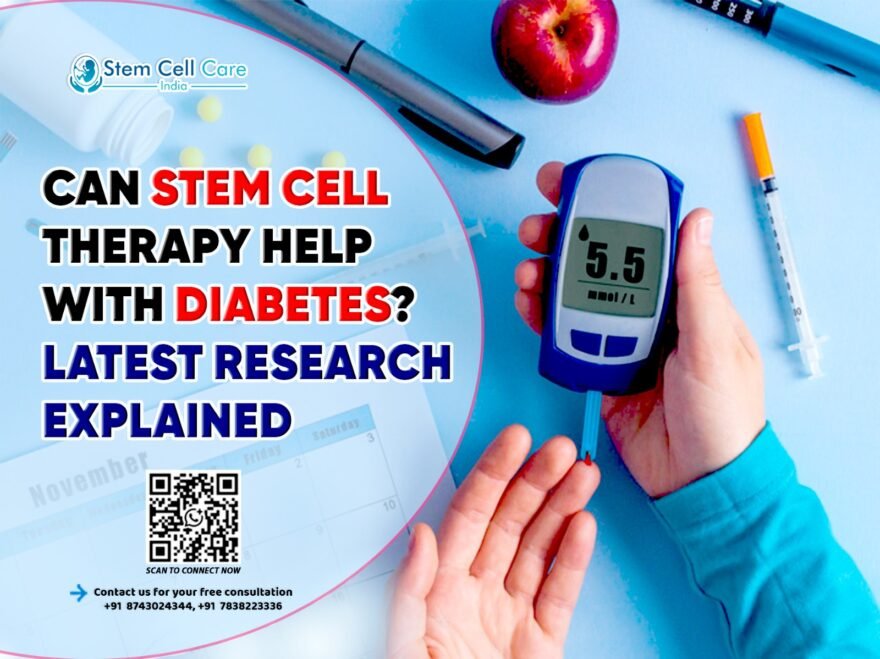Table of Contents
Summary: Diabetes is the most common and widespread condition that affects millions around the world every year. Although traditional treatments like insulin injection or oral medication do help manage blood sugar, they do not cure the condition. This led to research for other innovative medications like stem cell therapy. Could this approach be the future for diabetes? Let’s look at how it works, what research says, and what it means for the patients.
Dealing with diabetes in your day-to-day life can feel like a never-ending story of monitoring blood sugar, taking medications, and managing diet and lifestyle. Despite advances in treatment, many patients still struggle with complications like nerve damage, kidney damage, and heart disease. This is why turning to explore possibilities with stem cell therapy, which does not just aim to manage the symptoms but also tackles the root cause of the condition.
By repairing or replacing damaged cells in the pancreas, stem cell therapy has the potential to restore the body’s natural ability to produce insulin. But how close are we to making this a reality? Let’s find out.
What Is Stem Cell Therapy?
Stem cells are unique “master cells” with the ability to become other specialized cells. What is being hoped for in diabetes is that stem cells will give the body new beta cells for producing insulin in the pancreas.
- In Type 1 Diabetes, the immune system of the body targets the beta cells.
- In Type 2 Diabetes, beta cells decrease, or the body loses sensitivity to insulin.
Stem cell treatment will hopefully bring back healthy beta cell regeneration, reestablish insulin production, and enhance blood sugar balance.
Types of Diabetes and How Stem Cells May Help
Here are two main types of diabetes:
Type 1 Diabetes
- In this condition, the body’s immune system attacks and destroys insulin-producing cells.
- For this, stem cells can help in replacing these lost cells with new, functioning beta cells.
- Researchers are also looking for ways to protect new cells from immune system attacks.
Type 2 Diabetes
- The body begins to rebel against insulin, and the pancreas struggles to produce enough of it.
- Stem cell therapy can restore pancreatic function and allow the body to respond more favorably to insulin.
- It could cure the long-term need for insulin injections and tablets.
Latest Research and Findings
There has been exciting progress made in stem cell therapy research for diabetes:
Clinical Trials
- Studies and research show promising results in developing new insulin-producing cells.
- Some patients have minimized or even temporarily stopped insulin usage.
Encapsulation Technology
- Currently, scientists are working on developing a protective barrier to shield new beta cells from immune system attack, especially for type 1 diabetes.
India’s Role & Contribution
- Indian research centers are actively engaging in international trials and developing low-cost models for stem cell therapy for diabetes.
Encouraging results are so far available, but the majority of studies remain in experimental or trial phases. It could be a few years before stem cell therapy is adopted as a standard treatment for diabetes.
Benefits of Stem Cell Therapy for Diabetes
Stem cell therapy has the capability to change everything in the treatment of diabetes based upon the following potential benefits:
Reduced Insulin Dependency: You may be able to replace or greatly decrease the frequency of injections.
Better Sugar Control: Stem cells allow for better physiologic glucose regulation than injected insulin.
Reduced Complications: Stem cells may avoid long-term complications such as kidney failure, nerve damage, or coronary heart disease.
Improved Quality of Life: Fewer medications and fewer limitations can mean greater patient mobility.
Regenerative: Stem cells attempt to repair the dysfunctional pancreas, as opposed to medications that just treat the symptoms and not the problem.
The Future of Diabetes Treatment with Stem Cells
Scientists are sure that the treatment with stem cells can revolutionize diabetes care within 10 years. Although further research is necessary, it may one day become a viable, safe, and affordable treatment, either as a standalone therapy or as an adjunct to existing treatment therapies. For a few patients, it would offer a medical option that goes beyond symptom control and perhaps even cures their diabetes.
The Concluding Thoughts
One of the most promising fields in diabetes research is stem cell therapy. With a focus on regeneration rather than symptom control, it has the potential to change millions of lives. While not yet a cure, trials are currently moving closer to making it a viable possibility for sufferers.
If you are considering diabetes regenerative medicine, it is best to consult an expert. Stem Cell Care India provides accurate consulting and counseling to allow patients to understand whether stem cell treatment can be a suitable option for their condition. They will walk you through the latest advancements, availability of treatment, and eligibility criteria.
Commonly Asked Questions
Q1. Can stem cell therapy treat diabetes permanently?
Ans. For now, not quite a permanent cure, but evidence indicates it can decrease dependence on insulin and lead to better long-term health.
Q2. How safe is stem cell therapy for diabetes?
Ans. Initial trials indicate that it is largely safe when done under medical care, but more information on long-term consequences is required.
Q3. How long will it take for patients to see results?
Ans. Some of the patients can observe improvement within weeks, while others take months. Results are variable according to individual health and the seriousness of the condition.
Q4. Is stem cell therapy for diabetes available in India?
Ans. Yes, clinical research and trials are actively pursued by India. For the right advice, you may approach Stem Cell Care India to discuss the options available.


